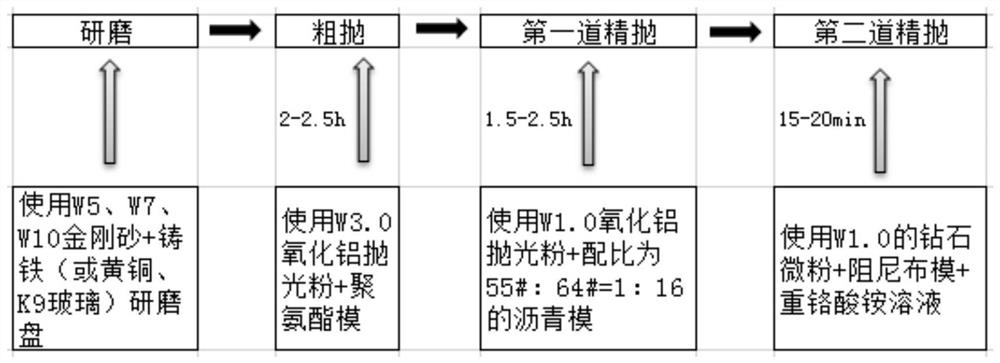Method of processing chalcogenide glass
A technology of chalcogenide glass and asphalt, which is applied in the field of infrared optics, can solve problems such as product surface scratches, achieve the effect of improving surface accuracy and stability, improving surface quality, and avoiding the removal of white fog
- Summary
- Abstract
- Description
- Claims
- Application Information
AI Technical Summary
Problems solved by technology
Method used
Image
Examples
Embodiment 1
[0033] This embodiment provides a method for processing chalcogenide glass. The method for processing chalcogenide glass in this embodiment comprises the following steps:
[0034] (1) Grinding the chalcogenide glass (specification: D40mm*2.4mm spherical surface; composed of As40Se60) with a brass grinding disc and corundum with a particle size of W10 to remove defects such as knife marks and chipping, while ensuring the thickness of the chalcogenide glass meet the requirements of the grinding step;
[0035] (2) Use a polyurethane mold and alumina polishing powder with a particle size of W3.0 to roughly polish the chalcogenide glass obtained in step (1), with a pressure of 2kgf / cm 2 , the spindle speed is 100RPM, the pendulum shaft speed is 60RPM, and the time is 2h to remove trachoma;
[0036] (3) Use the alumina polishing powder of asphalt mold and particle size W1.0 to carry out first fine polishing to the chalcogenide glass that step (2) obtains, wherein the asphalt of as...
Embodiment 2
[0040] This embodiment provides a method for processing chalcogenide glass. The method for processing chalcogenide glass in this embodiment comprises the following steps:
[0041] (1) Grinding the chalcogenide glass (specification: D103mm*14.85mm spherical surface; composed of As40Se60) with a grinding disc made of cast iron and corundum with a particle size of W10 to remove defects such as knife marks and chipping, while ensuring that the thickness of the chalcogenide glass reaches requirements for the grinding step;
[0042] (2) Use a polyurethane mold and alumina polishing powder with a particle size of W3.0 to roughly polish the chalcogenide glass obtained in step (1), with a pressure of 2kgf / cm 2 , the spindle speed is 100RPM, the pendulum shaft speed is 55RPM, and the time is 2.5h to remove sand holes;
[0043] (3) Use the alumina polishing powder of asphalt mold and particle size W1.0 to carry out first fine polishing to the chalcogenide glass that step (2) obtains, w...
Embodiment 3
[0047] This embodiment provides a method for processing chalcogenide glass. The method for processing chalcogenide glass in this embodiment comprises the following steps:
[0048] (1) Grinding the chalcogenide glass (specification: D25.4mm*4mm wedge; composed of Ge10As40Se50) with a grinding disc made of cast iron and corundum with a particle size of W7 to remove defects such as knife marks and chipping, while ensuring the chalcogenide glass The thickness meets the requirements of the grinding step;
[0049] (2) Use a polyurethane mold and alumina polishing powder with a particle size of W2.0 to roughly polish the chalcogenide glass obtained in step (1), with a pressure of 1kgf / cm 2 , the spindle speed is 95RPM, the pendulum shaft speed is 55RPM, and the time is 2h to remove sand holes;
[0050] (3) Use an asphalt mold and alumina polishing powder with a particle size of W1.0 to carry out the first fine polishing of the chalcogenide glass obtained in step (2), wherein the as...
PUM
 Login to View More
Login to View More Abstract
Description
Claims
Application Information
 Login to View More
Login to View More - R&D
- Intellectual Property
- Life Sciences
- Materials
- Tech Scout
- Unparalleled Data Quality
- Higher Quality Content
- 60% Fewer Hallucinations
Browse by: Latest US Patents, China's latest patents, Technical Efficacy Thesaurus, Application Domain, Technology Topic, Popular Technical Reports.
© 2025 PatSnap. All rights reserved.Legal|Privacy policy|Modern Slavery Act Transparency Statement|Sitemap|About US| Contact US: help@patsnap.com

